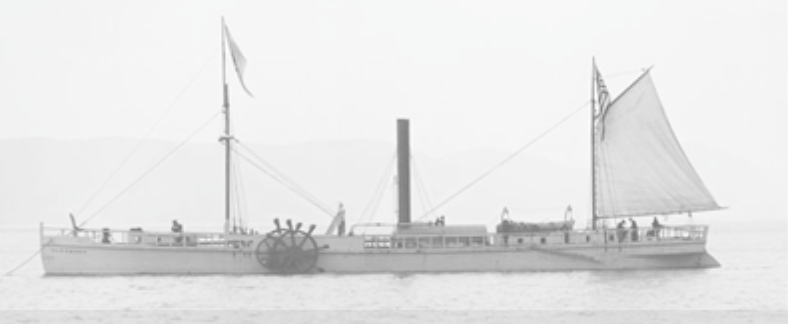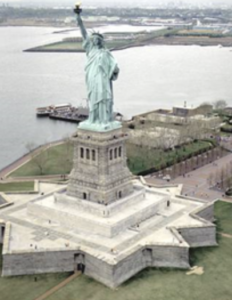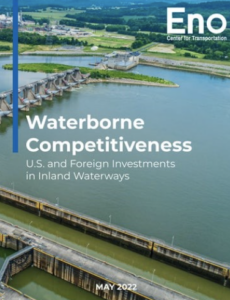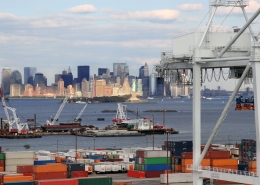Steam power was beginning to revolutionize transportation and the economy when James Monroe became the first U.S. president to travel on a steamboat in 1817.
Ten years earlier, the first successful commercial steamboat, the Clermont, had been launched on the Hudson River. The boat traveled about five miles per hour from New York to Albany, cutting down a typical four-day trip to 32 hours.
After the Clermont’s maiden voyage, the ship’s creator, Robert Fulton, wrote to his friend: “It will give a cheap and quick conveyance to the merchants on the Mississippi, Missouri, and other great rivers which are now laying open their treasures to the enterprise of our countrymen.”

Steamboats operating on the Mississippi, Hudson, and Great Lakes (and later steam-powered machines in New England’s textile mills) spurred a market revolution. Large factories began attracting farm girls to cities where they toiled over steam-driven looms producing cloth. While most Americans had been subsistence farmers, they increasingly became commercial farmers who specialized in certain crops and purchased goods outside their homes.
The revolutions in markets and transportation spurred each other on. Faster and more efficient movement of goods expanded markets, fueled industrialization, and accelerated globalization.
Although the Industrial Revolution had already begun by the time President Monroe took office, the power of steam accelerated it. Since the U.S. had few good roads in the early 19th century, Americans relied upon the Atlantic Ocean and navigable rivers to move goods. Steam overcame geographical barriers, and added speed and reliability.
Before steam-powered vessels, boats could easily travel downstream with the current, but they depended upon wind power and men with oars to travel upstream. Steam allowed trade to flourish because products could be easily shipped up the river as well as downriver. That made once remote lands more enticing for settlers to live, farm, and start businesses.
Population boomed along the Mississippi River, which runs more than 2,000 miles from Minnesota to New Orleans. Farmers bought land where they could easily ship their produce, and towns and cities prospered where goods were traded and stored.
The Mississippi River passes through ten U.S. states and borders St. Louis, Minneapolis, and Memphis. The economic boom did not just affect towns along the Mississippi River, but also cities whose rivers connected with the Mississippi such as Pittsburgh, Louisville, and Cincinnati. For instance, Missouri’s population had fewer than 20,000 people in 1810, but more than 140,000 twenty years later. New Orleans’ population rose from 27,000 to more than 100,00 people over the same period.
Changing the sources of power can have profound impacts. Today, as the U.S. moves from gasoline powered to electric vehicles, the owners of gasoline stations, oil refineries, and auto repair shops will need to reinvent themselves. A global race is on to secure a steady supply of lithium, a critical component of batteries.
Likewise, the use of steam to power ships reshaped the economy. Operating, building, and repairing steamboats created new jobs and led people to relocate. Demand soared for lumber and coal, and refueling stops were set up along rivers.
Monroe and the Army Corps
When James Monroe was a lieutenant colonel in the Revolutionary War, he was a strong advocate for expanding the role of the U.S. Army Corps of Engineers to improve transportation infrastructure. During his presidency, the Army Corps was the only formally trained group of engineers in the country.
The Corps had played key roles in the Revolutionary battles at Bunker Hill, Saratoga, and Yorktown. It was reestablished in 1802 and given the responsibility for founding and operating the U.S. Military Academy at West Point, as well as constructing and repairing fortifications. The remains of one of those forts, the 11-point Fort Wood, now serves as the base of the Statute of Liberty in the New York harbor.

In 1824, President Monroe signed the General Survey Act, which asked the Army Corps to survey the most important potential roads and canals in the U.S. After the completion of the survey, Congress authorized President Monroe to improve the navigation of the Mississippi and Ohio Rivers by removing trees and other impediments that were endangering safety and navigation.
Monroe reported to Congress that year: “It need scarcely be remarked that the more extensively these Corps are engaged in the improvement of their country, in the execution of the powers of Congress, and in aid of the states in such improvements as lie beyond that limit, when such aid is desired, the happier the effect will be in many views of which the subject is perceptible. By profiting of their science the works will always be well executed, and by giving to the officers such employment our Union will derive all the advantage, in peace as well as in war, from their talents and services which they can afford.”
The Army Corps is an unusual organization in the U.S. because it provides both military and civilian services. The Army Corps constructed the Washington Monument and the Panama Canal. During World War II, the Corps oversaw the building of the first atomic bomb and when American troops landed on the beaches of Normandy, the Corps quickly removed obstacles and built passable roads so that personnel and equipment could be moved off the beach.
The Corps is still responsible for keeping shipping channels navigable and accommodating ever larger ships. For example, about six million cubic yards of sediment needs to be dredged annually from the New York harbor because fresh water from three rivers constantly carries in silt, sand, and muck. Maintaining navigable depths in shipping channels is critical to waterborne commerce, just as roads need to be paved, potholes filled, and snow cleared on highways.
 Today, the Mississippi and Hudson Rivers along with the rest of the nation’s 12,000-mile “inland waterway” network continues to serve energy, agriculture, and other freight shipments. The network moves over 500 million tons of freight annually, frequently carrying goods that are too large for trucks or rail cars, such as windmill blades, booster rockets, and oversize machinery. For more information, see Eno’s 2022 report: Waterborne Competitiveness U.S. and Foreign Investments in Inland Waterways.
Today, the Mississippi and Hudson Rivers along with the rest of the nation’s 12,000-mile “inland waterway” network continues to serve energy, agriculture, and other freight shipments. The network moves over 500 million tons of freight annually, frequently carrying goods that are too large for trucks or rail cars, such as windmill blades, booster rockets, and oversize machinery. For more information, see Eno’s 2022 report: Waterborne Competitiveness U.S. and Foreign Investments in Inland Waterways.
Check out all of the articles in our presidential series in our archive!
















